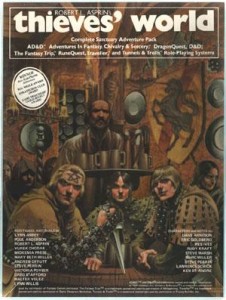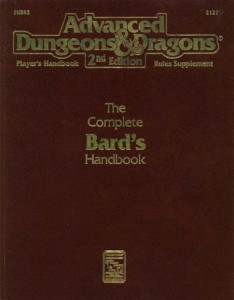 It was the mid 90’s and I was taking a break from running Palladium games RPGs. We had a great Robotech campaign that had just ended with the devastation of the surface of Earth and we were looking to do something a bit different. One of the guys suggested running a Thieves’ World campaign using 2nd edition D&D rules. Until then I didn’t even know there were RPG books for Thieves’ World. The system turned out to be pretty good for what we wanted to do.
It was the mid 90’s and I was taking a break from running Palladium games RPGs. We had a great Robotech campaign that had just ended with the devastation of the surface of Earth and we were looking to do something a bit different. One of the guys suggested running a Thieves’ World campaign using 2nd edition D&D rules. Until then I didn’t even know there were RPG books for Thieves’ World. The system turned out to be pretty good for what we wanted to do.
Here we are now almost twenty years later and RPGs have advanced and been over analyzed so that all the old games have had their flaws dissected and lots of dirty laundry has been aired to the public. At the time though it was doing things that other games were not. The kit system has taken a lot of flak since then but I liked it then and still like it now. Few Kits were created equally but that didn’t matter for us. It was a great way to help mechanically distinguish a character and call him something besides Fighter or Thief. The setting only has humans and it being low magic it restricted the kinds of classes that we would play. The kit system helped make characters of the same class really seem different.
That first campaign we had four characters. I don’t recall what the specific kits were but we had a Fighter, a thief, a ranger, and my character a Bard. I took the True Bard Kit from the Complete Bard’s Handbook my favorite of the 2e class and race books. My character was a musician and singer but also had many disguises. We started off the campaign in a place called Downwind the poorest of the cities districts. It has very few permanent buildings; most are shacks and tents. The way we ran it it had a gang problem and my character did not want to be seen there so he looked differently when there. Also, he was rightfully fearful of being mugged as of the group my character made the most money with street performances and eventually joined a Bard’s guild.
When the characters were made we connected them through backstory. We needed a reason to trust each other and that was one of the few requirements the DM demanded. The other one was create in the backstory how your character ended up with almost nothing in the poorest district in town. Starting money was in copper instead of gold. The copper coins could be broken off into ten pieces called Bits so there was currency smaller than a copper. Many of the items in the PHB cost was in silver instead of gold but starting out we could afford very little.
The characters did not have a place to live so we found some people and convinced them through threat of violence to let us live were they had been living. Alignment was something we ignored. This game was about day-to-day survival more than standing up for Good verse Evil or anything like that. Those are concepts that can easily be explored in Thieves’ World game but it wasn’t something we did. Each day we had to earn money for food and with luck we would save some to eventually buy better equipment or be able to afford a real house in a safer district. Each day we had each character go out and earn. The Fighter would try to get a job as body guard or something, the thief picked pockets, the Ranger would offer services as a city guide, and my character would sing for money. All of those types of activities were usually just done with a skill roll and maybe some role play if something interesting was happening with it. The nights are where the bulk of the gaming time was spent.
 The DM introduced a fighting ring that existed in the Maze, the most dangerous section in the city. It took us a few sessions to learn of it and figure out where it was. I like that it was not just handed to us. There anyone could fight and it was to knockout or one side taps out, not to the death, though death could happen. Anyone could fight in what was called the scrub fights. In these you had no idea what type of character you would be facing. The DM had a table he rolled randomly. So, a character could get lucky and face a zero level fisherman or get unlucky and face an experienced fifth level fighter. For fighting a character would get a copper and for winning you would get silver. The real money came in the gambling. At times it did seem like we were playing Bloodsport the RPG as this was a major focus of the campaign. There were a lot of NPCs we met that were combatants or spectators. Once a fighter made a name for himself he could be invited to special fights or events. The money and bets would become a lot better at those. And just like real life some nights we hit big and other nights we lost our shirts. Healing was also an issue so if you lost a fight big time it usually meant you didn’t make any money and you had to pay to get the character healed or else he was going to be really low on HP for days or weeks.
The DM introduced a fighting ring that existed in the Maze, the most dangerous section in the city. It took us a few sessions to learn of it and figure out where it was. I like that it was not just handed to us. There anyone could fight and it was to knockout or one side taps out, not to the death, though death could happen. Anyone could fight in what was called the scrub fights. In these you had no idea what type of character you would be facing. The DM had a table he rolled randomly. So, a character could get lucky and face a zero level fisherman or get unlucky and face an experienced fifth level fighter. For fighting a character would get a copper and for winning you would get silver. The real money came in the gambling. At times it did seem like we were playing Bloodsport the RPG as this was a major focus of the campaign. There were a lot of NPCs we met that were combatants or spectators. Once a fighter made a name for himself he could be invited to special fights or events. The money and bets would become a lot better at those. And just like real life some nights we hit big and other nights we lost our shirts. Healing was also an issue so if you lost a fight big time it usually meant you didn’t make any money and you had to pay to get the character healed or else he was going to be really low on HP for days or weeks.
The first month or so we played was about getting money, staying alive, and eventually moving out of Downwind. We made a few friends but many more enemies. Like I mentioned we had gangs in Downwind and they were always a problem. We took one gang out completely in a big battle through the tents other basic structures in a pretty cool long drown out battle.
Each character had their own goals. Some were escaped slaves or wanted criminals so they wanted to become legally freemen. There were many guilds in the city that would interest a character and having guild status was an important achievement for the characters. We meet and interacted with many of the different NPCs from the stories and even though most of them were cooler and more powerful than us the focus was kept nicely on the characters.
When 3e D&D came out we came back to D&D from playing Star Wars d6 and once we got a good feel for the system we played in a Thieves’ World campaign. It had the same feel as the first but the system worked a lot better. The feat system allowed for a wider range of character abilities. Just the ability for anyone to take Improved Unarmed Strike helped for the fighting ring and AoO for characters that didn’t have it helped divide the skilled from the unskilled fighters. The skill system was also easier to use then the non-weapon proficiencies and because of the nature of the campaigns skills were always important.
 One thing we kept was the idea of fame from the Bard’s Handbook. It had fame that lessened depending on how far different cities were and we used that idea except with districts. So, a character could be well known in the fishermen’s area but unheard of in the Temple district. Magic was very rare and dangerous. My character once got a wand and I spent weeks trying to figure out how to return it to its owner and get a reward instead of being accused of stealing it, which I had done. One of the other players said at the time the smartest thing I could do is go to the ocean and toss it in there and it turned out he was right. In another campaign the players were 8th level when they got a hold of a working crossbow and they celebrated. I don’t think there is another D&D game anywhere that something like that could happen. We had master work items but never anything magical expect for one use items like potions and scrolls and maybe something else simple. It was a very low magic and gritty campaign. It is not the style of game many people would enjoy but it was a lot of fun for us.
One thing we kept was the idea of fame from the Bard’s Handbook. It had fame that lessened depending on how far different cities were and we used that idea except with districts. So, a character could be well known in the fishermen’s area but unheard of in the Temple district. Magic was very rare and dangerous. My character once got a wand and I spent weeks trying to figure out how to return it to its owner and get a reward instead of being accused of stealing it, which I had done. One of the other players said at the time the smartest thing I could do is go to the ocean and toss it in there and it turned out he was right. In another campaign the players were 8th level when they got a hold of a working crossbow and they celebrated. I don’t think there is another D&D game anywhere that something like that could happen. We had master work items but never anything magical expect for one use items like potions and scrolls and maybe something else simple. It was a very low magic and gritty campaign. It is not the style of game many people would enjoy but it was a lot of fun for us.
The Thieves World campaign I ran used the Rules Cyclopedia. It has always been one of my favorite versions of D&D. It has a workable skill system that we liked. It has the classes needed and it is easy to still ignore the demi humans since they were not part of the setting. The mystic is an interesting class and one of the players used it. Not having to rely on weapons and armor was a good advantage.
My campaign started before the first book and took them through the conquering of the city by the Rankans. I focused on the townsfolk really not caring who was in charge as long as their lives mainly remained the same. The day -o-day grind of basic survival was still the focus but we did travel outside the city some and dealt with pirates and raiders more than in previous campaigns.
I’d like to run the setting again but it would be a tough sell for my players because it is a non-heroic campaign. I would use Pathfinder and mix in some of the new Thieves World mechanics from the Green Ronin books. I ran the Council of Thieves Adventure Path Paizo made and that worked well for a campaign all in one city. I think that will be the closest I get to Thieves World for some time.
Chris Gath. I’ve been gaming since 1980 playing all kinds of games since then. In the past year I’ve run Pathfinder, Dungeon Crawl Classic, Paranoia, and Mini d6. My current campaign is mini d6 and we are using that for a modern supernatural conspiracy investigative game. On some forums I’m known as Crothian and I’ve written a few hundred reviews though I took a sabbatical from reviewing for a few years as it burnt me out. I was also an judge for the Gen Con awards (ENnies) six times. Jeff, the owner of this blog, is one of my players and a good friend.

Sounds like good times!
hey man loved the article i recently watched spoony’s stories about thieves world and have in recent months have played with the idea of using pathfinder rules which my friends are already familiar with. it sucks that this setting is not as well known as it should be today